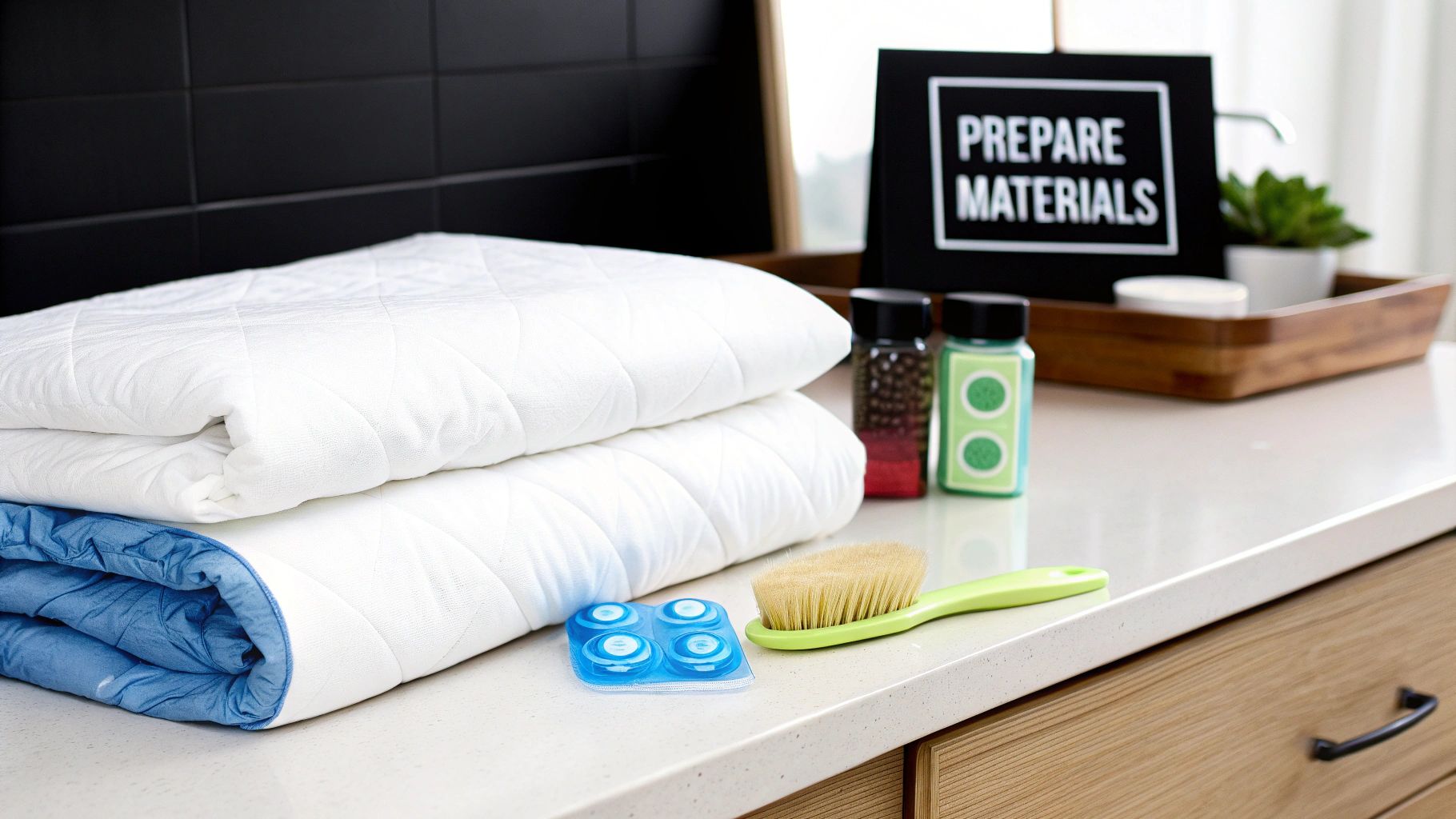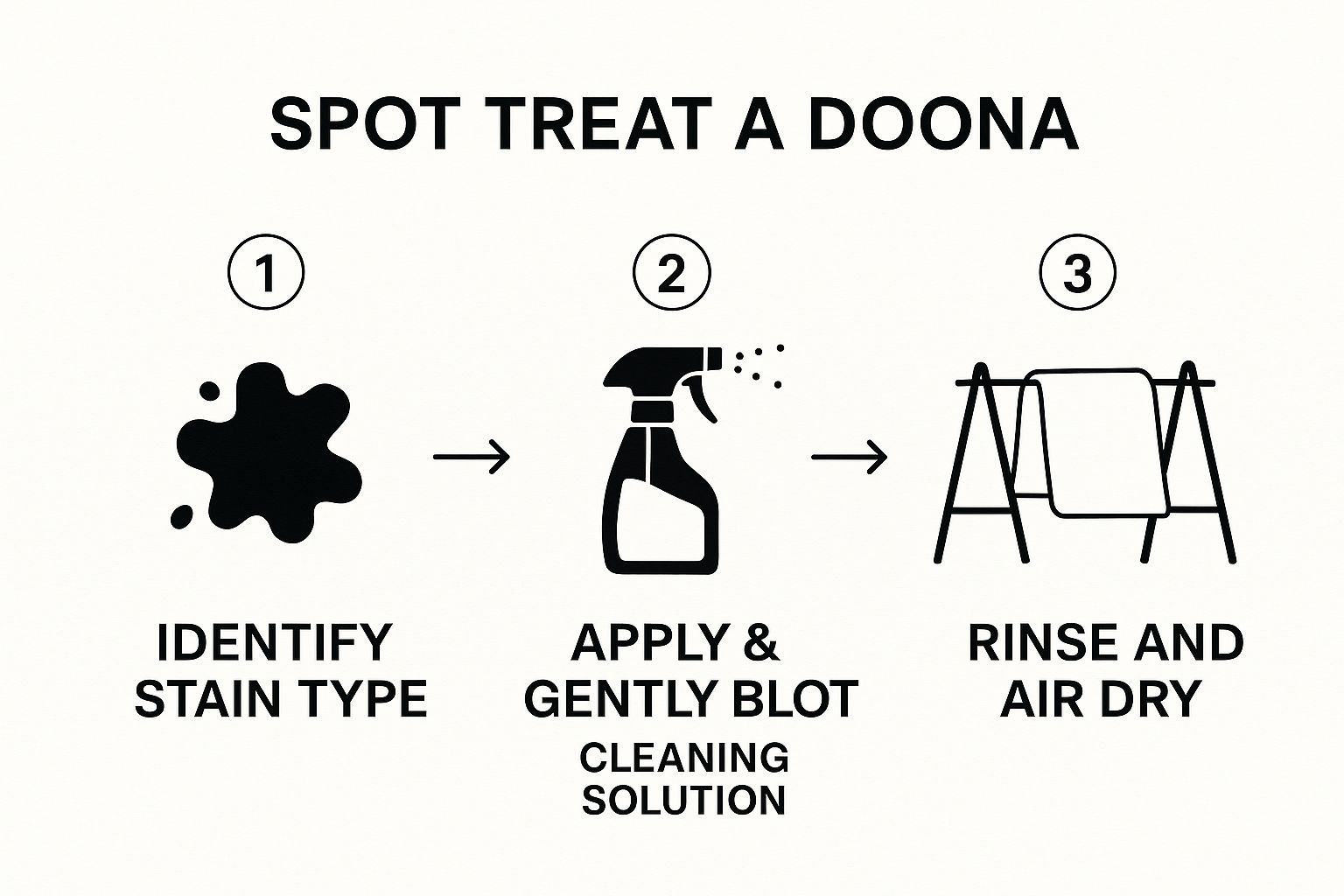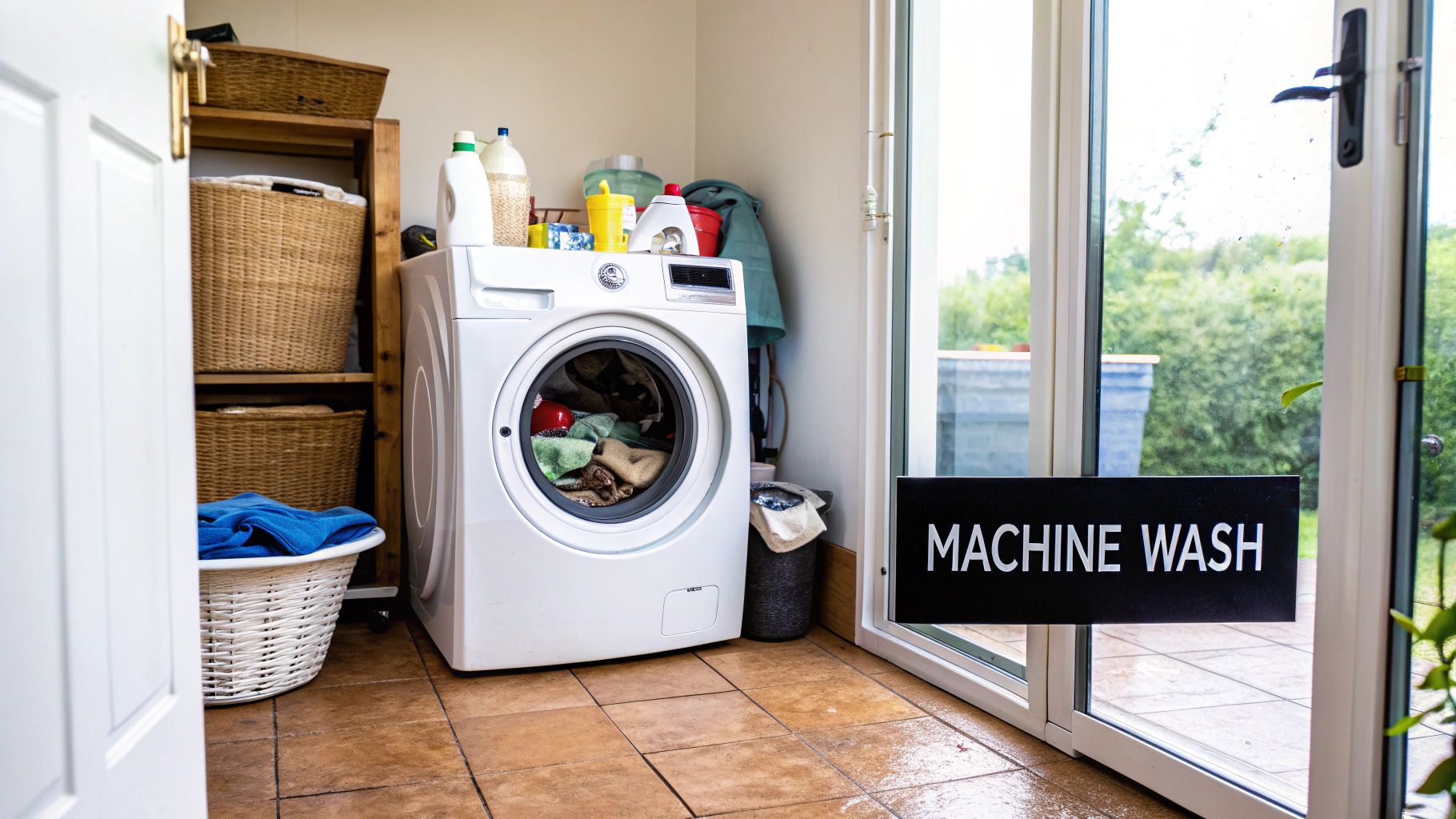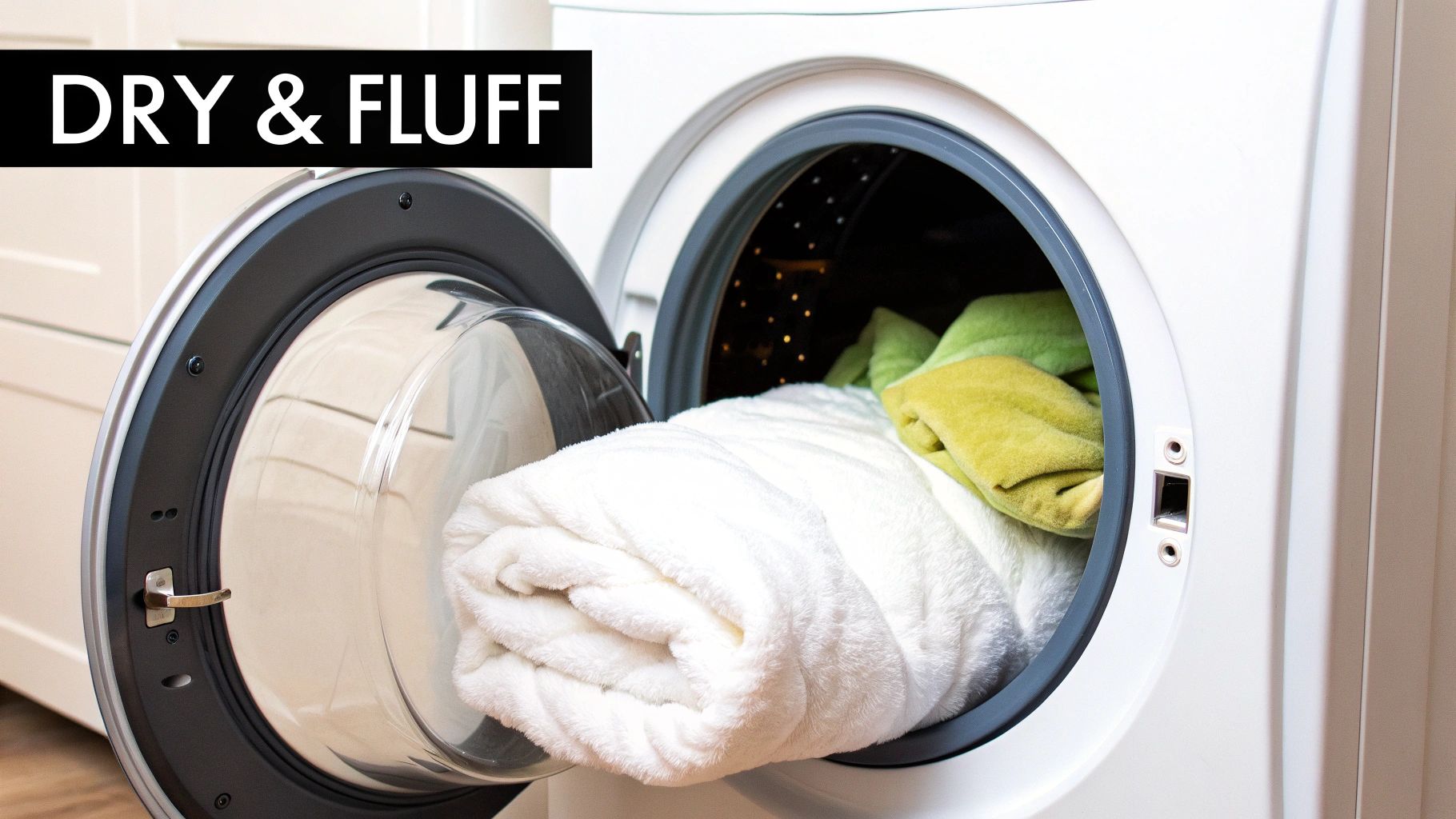Ever pulled your doona out of the wash, only to find it lumpy, damp, and smelling a bit... off? Learning how to wash a doona correctly can feel like a daunting chore, but it’s simpler than you think. The secret lies in a few key steps: checking the care label, using a gentle wash cycle, and ensuring it's completely dry. Get these right, and you'll keep your doona fluffy, fresh, and hygienic for the perfect night's sleep.
Why Washing Your Doona Is So Important
A clean doona is more than just a fresh look; it's essential for a healthy sleep environment. While your doona cover catches most of the daily grime, it can't block everything.
Over time, your doona absorbs sweat, body oils, and millions of skin cells. This creates a perfect home for dust mites and bacteria. A study from the University of Worcester found that a pillow can accumulate up to a million fungal spores in just a few years—and the same applies to your doona. Regularly washing your doona is a simple way to protect your health.
Regular cleaning helps to:
- Reduce Allergies: Washing removes dust mites and allergens, which can significantly reduce symptoms like sneezing and congestion for allergy sufferers.
- Promote Clearer Skin: A clean sleeping surface minimises contact with oils and bacteria that can contribute to breakouts.
- Extend Your Bedding's Lifespan: Proper washing removes dirt and corrosive body oils that can break down delicate fibres over time.
First, Know Your Doona’s Material
Before you start, you need to know what your doona is made of. The filling dictates everything, from water temperature to the drying method. A wool doona, for example, needs a completely different approach to a synthetic one to avoid shrinkage.
It's also worth considering your home's water quality. If you live in an area with hard water, understanding hard water and its solutions can be a game-changer, as it affects how well your detergent works.
A Real-World Example: I once helped a customer who couldn't understand why their delicate goose-down quilt from our Sienna Living Feather & Down collection came out of the wash flat and clumpy. The culprit? They'd used a standard hot wash, the same they used for their towels. The high heat had damaged the delicate down clusters. Your care tag is always your best guide.
Getting to know the specific needs of your doona—whether it's one of our popular bamboo quilts or another type—is the secret to keeping it fluffy and clean for years.
The Pre-Wash Checklist: What to Do First
Before you toss that doona in the wash, a few minutes of prep can be the difference between a clean, fluffy result and a lumpy, damaged mess. This simple pre-wash routine will guarantee a better outcome.

First, find the care label. It’s your doona’s instruction manual from the manufacturer, containing all the secrets—water temperature, the right cycle, and whether it can be machine-washed at all. Skipping this step is a gamble you don't want to take.
Check for Stains and Damage
Lay your doona out flat and give it a good look. You're searching for small rips, loose threads, or weak seams. The intense tumbling of a washing machine can turn a tiny hole into a disaster, spewing filling all over the drum. A quick fix with a needle and thread now will save you a massive headache later.
Next, hunt for any specific stains. Bedding often falls victim to sweat, body oils, or the classic morning coffee spill. Treating these spots before the main wash helps your detergent work properly.
Actionable Tip: For tough stains, make a simple paste from baking soda and water or use a gentle, enzyme-based stain remover. Dab it on the area, let it sit for about 20-30 minutes, and then gently blot it away before washing.
This pre-treatment is especially effective for lifting grime without being too harsh on delicate materials, like the fabric in our gorgeous bamboo quilts. For more specific advice, check our guide on how to clean bed stains like a pro.
Is Your Machine Big Enough?
Finally, check your washing machine. A doona needs room to move freely to get a proper clean. If it’s squashed, water and detergent can’t reach every part, leaving you with soapy or dry patches.
A simple rule of thumb: your doona shouldn't take up more than two-thirds of the drum. If you're wrestling with it to shut the door, your machine is probably too small. In that case, your best bet is to head to a local laundromat and use one of their large, commercial-sized machines.
Washing your doona at least every six months is recommended to clear out dust mites, skin cells, and sweat. A clean doona isn't just nice—it's key to a hygienic sleep environment. You can find more tips on keeping your doona clean at masterdrycleaners.com.au.
How to Wash a Doona: The Step-by-Step Method
With the prep work done, it’s time to get washing. Nailing this part will ensure a brilliantly clean, fluffy doona rather than a lumpy disappointment. Let's walk through the exact machine settings and detergent choices so you know exactly how to wash a doona like a pro.
Load and Balance Your Machine
First, get the doona into the machine correctly. Don't just shove it in. Arrange it evenly around the drum to create a balanced load. This crucial step stops your machine from rattling during the spin cycle, which can cause damage and lead to a poor wash.
If you have a top loader with a central agitator, gently guide the doona around it in a horseshoe shape. For front-loaders, feed it in without packing it too tightly. The key is leaving enough space for water and soap to circulate.
Choose the Right Detergent and Settings
When it comes to detergent, less is more. I recommend a mild, low-suds liquid detergent. Powdered detergents don't always dissolve properly on bulky items, leaving a chalky residue. It's also vital to avoid common laundry mistakes like using too much detergent; excess soap is hard to rinse out.
Important Takeaway: Skip the fabric softener. It coats the fibres of the filling—especially delicate down—which can reduce its loft and insulating power over time.
Set your machine to a gentle or delicate cycle. Use cool or warm water, around 30-40°C, as hot water can cause shrinkage and damage the filling. I always recommend running an extra rinse cycle. It takes longer, but it ensures every bit of soap is flushed out, preventing potential skin irritation.
Quick Washing Guide by Doona Material
Every doona is different. Here's a quick cheat sheet to help you choose the right settings for your specific material.
| Doona Material | Recommended Cycle | Water Temperature | Detergent Type | Extra Tips |
|---|---|---|---|---|
| Microfibre/Polyester | Gentle or Delicates | Warm (up to 40°C) | Mild Liquid | Very resilient; add an extra rinse to ensure no soap residue. |
| Down & Feather | Delicate or Hand Wash | Cool (30°C) | Down-Specific Wash | Use minimal detergent; add tennis balls during drying to fluff. |
| Wool | Wool or Hand Wash | Cold (20-30°C) | Wool-Specific Detergent | Never use hot water! Avoid high spin speeds to prevent felting. |
| Bamboo | Gentle or Delicates | Cool (30°C) | Mild, Eco-Friendly | Avoid harsh chemicals and softeners to protect natural fibres. |
Handling Specific Doona Materials
As the table shows, different materials need a slightly different touch. A tough synthetic doona can handle a standard gentle cycle, but natural fibres demand more care.

Here are a few more specific pointers:
- Wool Doonas: These are naturally antibacterial but notorious for shrinking. You must use a wool-specific detergent and the wool cycle. If you don't have one, a cold, gentle wash is your only other option.
- Down and Feather Doonas: The delicate clusters inside can be damaged by aggressive spinning. Always use the gentlest cycle. For a deeper dive, our essential guide on how to wash and care for down quilts has everything you need.
- Bamboo Doonas: Treat our Sienna Living bamboo doonas right with a gentle, cool wash. Keeping high temperatures and harsh chemicals away is the secret to maintaining their luxurious feel.
Mastering the Art of Drying Your Doona
Washing your doona is only half the battle; the drying stage is where you lock in that fresh, clean feeling. Getting this wrong can lead to clumpy filling, a musty smell, and a ruined doona. Correct drying is essential to restore its loft and ensure it's completely hygienic.

Using a Tumble Dryer Effectively
A tumble dryer is often the quickest option. The golden rule is to use a low heat, gentle cycle. High heat can scorch delicate fillings like down or cause synthetic fibres to melt and clump.
To achieve that brand-new, cloud-like fluffiness, add a few wool dryer balls or clean tennis balls to the drum. They bounce around, breaking up clumps and helping warm air circulate more evenly.
Actionable Tip: Don't just set it and forget it. Pause the dryer every 30-40 minutes. Pull the doona out, give it a vigorous shake, and rotate it before putting it back in. This simple action redistributes the filling and prevents damp spots.
The Art of Air-Drying
If you don't have a large dryer, patience is key. The goal is to maximise airflow. Don't just drape your doona over a single clothesline, as this traps moisture in the middle.
Instead, hang your doona over several parallel lines to create channels for air to move through. Rotate it every few hours, flipping it over to ensure every part gets sun and breeze. Be aware that a large doona can take a long time to air-dry, risking mildew.
Ensure It's Completely Dry
Whether you've used a dryer or the clothesline, this final check is crucial. A doona that feels dry on the outside can still hide moisture deep inside, creating a breeding ground for mould.
Before putting the cover back on, feel the doona all over, paying close attention to the thickest parts and corners. If you feel any coolness or dampness, it needs more time. If your doona is still damp after a full dryer cycle, you may need to troubleshoot a tumble dryer not heating.
When to Call in the Professionals
While knowing how to wash your doona is a great skill, sometimes handing it to a professional is the smartest move. It can save you from a laundry disaster and protect your investment in quality bedding.

If Your Doona Is Too Delicate or Large
The most obvious sign is on the care tag. If it says “dry clean only,” take it seriously. Trying to wash materials like silk or heavy wools at home can lead to a shrunken, clumpy mess.
Size is the other big factor. A super king doona just won't fit into a standard home washing machine. A professional launderette has industrial-sized machines that give your doona the space it needs to get thoroughly cleaned.
Think of it this way: a professional clean is a small investment in your doona's lifespan. For a beautiful piece like one of our Sienna Living Feather & Down quilts, it’s the best way to keep it feeling lofty and luxurious for years.
The Perks of a Professional Clean
Professional cleaners use specialised detergents and powerful, temperature-controlled dryers. This avoids the risk of mildew from a partially damp filling, a common headache when drying a bulky doona at home.
- A Deeper Clean: Industrial machines ensure water reaches every part of the doona.
- Expert Drying: Large-capacity dryers restore loft and prevent clumping.
- Stain-Fighting Know-How: Pros can tackle stubborn stains without harming the fabric.
In Australia, a professional doona clean typically costs between AUD $27.50 to $41.25, depending on size and material. You can find out more about professional doona cleaning costs at thelaundrylady.com.au. When in doubt, call in the pros.
Your Top Doona Care Questions Answered
Even with experience, questions can arise. Here are practical answers to some of the most common doona care queries.
How Do I Get Yellow Stains Out of My Doona?
Yellow stains are usually a build-up of sweat and body oils. Tackle them before they set. A paste of baking soda and water works well as a pre-treatment. Apply it to the spot, let it sit for at least 30 minutes, then gently brush it off before washing. An enzyme-based stain remover is also effective.
Actionable Tip: For a white doona, air-drying it outside on a bright day can act as a natural bleach. UV rays help fade yellow tones without harsh chemicals.
Can I Wash a Doona That Says "Dry Clean Only"?
If the label says "dry clean only," you should listen. It's not just a suggestion. Delicate materials like silk, some high-loft down, and certain wools can be ruined by a machine wash. Water can cause fibres to shrink, clump, or 'felt,' destroying the doona's texture and warmth.
Why Does My Doona Smell Musty After Washing?
That musty smell means your doona isn't completely dry inside. Even if the outer fabric feels dry, trapped moisture can breed mildew. You'll likely need to wash it again. This time, add a cup of white vinegar to the rinse cycle to kill odour-causing bacteria. Then, be ruthless with the drying process until it is 100% bone-dry. For more detailed advice, our complete guide on how to wash doonas covers all the bases.
How Often Should I Wash My Doona Cover?
Your doona cover needs washing much more often than the doona itself. It’s the layer right against your skin. As a rule, wash your doona cover weekly, or every two weeks at most. This simple habit keeps the doona insert fresh for much longer.
A Fresh Start for a Better Sleep
Now you have the knowledge to wash your doona with confidence, ensuring it stays fresh, fluffy, and hygienic. A clean bed is the foundation of a great night's sleep, and with these simple, actionable steps, you can easily maintain a healthy and inviting sleep sanctuary.
Ready to upgrade your bedding? At Sienna Living, we believe a perfect night's sleep starts with beautifully clean, high-quality materials. Explore our luxurious range of bamboo quilts and feather & down doonas to find the perfect foundation for your best sleep yet.

